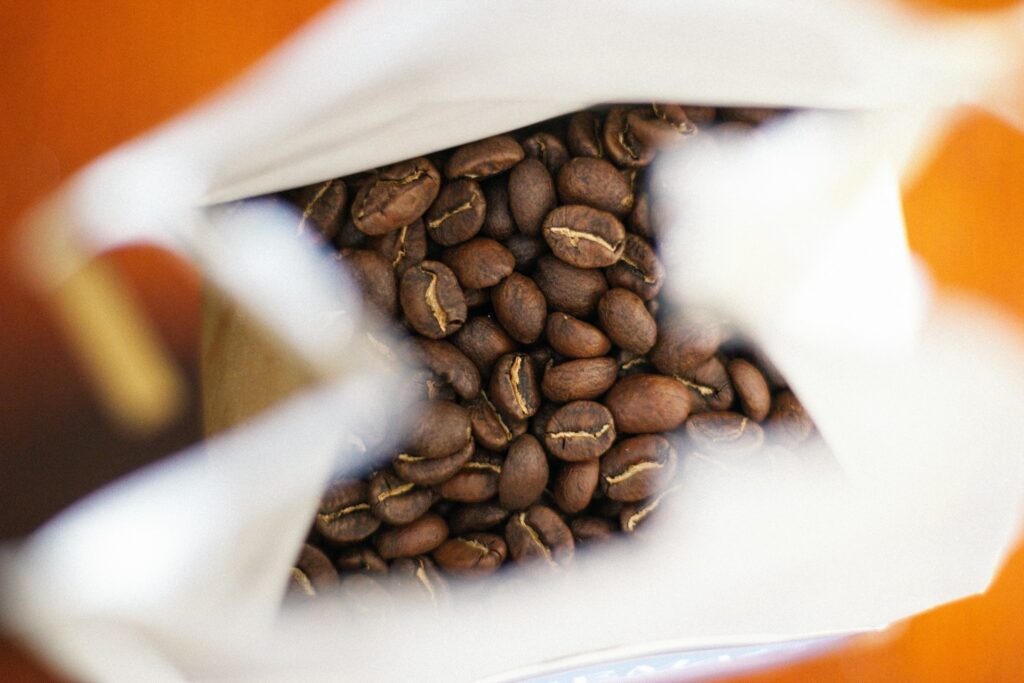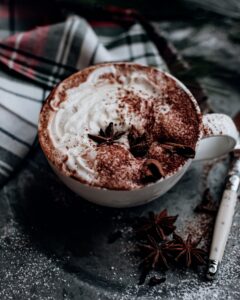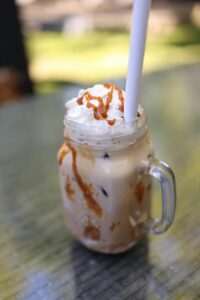Is your morning cup a bright spark or a bold punch? Coffee lovers have argued this for decades, and the answer often comes down to the roast.
Roasting transforms green beans into the fragrant brew we know and love. Light roasts highlight natural flavors like fruit and florals, while dark roasts bring out deep, smoky richness.
So which should you choose—light or dark? That’s the million-bean question, and we’re about to break down the flavor and caffeine differences so you can sip with confidence!
| Feature | Light Roast | Dark Roast |
|---|---|---|
| Flavor | Bright, fruity, floral, acidic | Bold, smoky, chocolatey, nutty |
| Appearance | Light brown, dry surface, no oils | Dark brown to black, shiny, oily surface |
| Caffeine | Slightly higher by volume (denser beans) | Slightly lower by volume (less dense) |
| Body | Lighter, tea-like | Heavier, fuller, rich |
| Best Brewing | Pour-over, drip, AeroPress | Espresso, French press, moka pot |
| Overall Vibe | Bright and nuanced | Deep and robust |
What Does Roasting Actually Do?
Roasting is where coffee’s true personality comes alive.
Green beans start out grassy and bland, but once heat hits them, a chain reaction kicks in—sugars caramelize, acids mellow or intensify, and oils move to the surface depending on how long the beans stay in the roaster.
Light roasts are pulled earlier, which keeps more of the bean’s natural acidity, fruity tones, and subtle sweetness intact.
Dark roasts, on the other hand, go through longer, hotter cycles that push past caramelization into smoky, bittersweet territory, with shiny oils often coating the bean.
These changes don’t just affect flavor; they also shape how we perceive strength and caffeine.
Despite popular belief, roasting doesn’t magically pile on caffeine in darker beans—in fact, the longer beans roast, the more mass they lose, so by volume, a light roast may give you a slightly bigger caffeine kick.
In short, roast level is the compass guiding both taste and buzz, making it the single most important factor when deciding how your cup greets you in the morning.
Light Roast: Characteristics
Flavor Profile
Light roasts are the extroverts of the coffee world—bright, lively, and always ready to surprise you. Their taste often leans toward fruity, citrusy, or even floral notes, depending on the bean’s origin.
You might notice hints of berries, jasmine, or honey that you’d never find in a darker roast.
This is because the lighter roast preserves more of the bean’s natural flavors, giving you a cup that feels fresh and complex rather than heavy and smoky.
Appearance
Visually, light roast beans look lighter brown with a matte finish, almost dry compared to their darker cousins.
You won’t see much oil on the surface because they haven’t been roasted long enough for the oils to rise to the surface.
If you ever spill a bag of light roast on the counter, you’ll notice it looks more like toasted nuts than shiny chocolate-covered espresso beans.
Caffeine Content
Here’s where things get interesting. Light roasts often pack slightly more caffeine per scoop than dark roasts, simply because they’re denser.
Since they spend less time in the roaster, they retain more of their original mass. But don’t expect a rocket-fuel difference—the caffeine gap isn’t dramatic.
It’s more like the difference between jogging and brisk walking than running a marathon.
Best Brewing Methods
Light roasts shine brightest when brewed with methods that highlight their delicate flavors.
Pour-over and drip bring out the nuanced acidity and fruity sweetness, while an AeroPress can balance those flavors with a touch of body.
If you want to taste the coffee’s “true story,” light roast with a slow, careful brew is your best bet.
Dark Roast: Characteristics
Flavor Profile
Dark roasts are the strong, silent type—bold, smoky, and full of character. Their flavors lean heavily on chocolate, toasted nuts, and sometimes even a hint of spice or charcoal.
The longer roasting time burns off the bean’s natural acidity, so instead of bright fruit notes, you get a cup that feels rich, deep, and comforting.
It’s the kind of coffee that doesn’t whisper but it booms, like a bassline in a jazz club.
Appearance
You can spot dark roast beans instantly. They’re dark brown to nearly black, and often have a glossy shine thanks to oils pulled to the surface during roasting.
If you’ve ever opened a bag and noticed beans that almost look lacquered, that’s a dark roast.
Those oils contribute to the heavy body in your cup, and they’re also why bags of dark roast can sometimes leave little stains on your fingers.
Caffeine Content
Here’s the twist: despite tasting “stronger,” dark roast usually has slightly less caffeine by volume than light roast.
The longer roasting process causes the beans to lose density, so a scoop of dark roast has fewer solid particles than a scoop of light roast.
However, taste perception can deceive you because the flavor is more intense, and people often claim it hits harder.
In reality, the difference is small enough that you won’t notice unless you’re counting milligrams.
Best Brewing Methods
Dark roasts truly shine in brewing methods that emphasize body and strength. Espresso machines love them, pulling out that syrupy, smoky punch.
A French press amplifies the richness, while a moka pot creates an old-school, stovetop espresso vibe.
If you’re after a cup that feels robust and powerful, like something that could stand up to milk, sugar, or even whipped cream, dark roast is your reliable workhorse.
Flavor Showdown: Side-by-Side Comparison
Acidity vs. Bitterness
When you sip a light roast, the first thing you’ll likely notice is its acidity—but don’t think “sour lemon face.”
In coffee terms, acidity means brightness, like the crisp snap of a green apple or the tang of a ripe berry.
Dark roast flips the script. Its longer roasting time burns off much of that acidity and replaces it with a heavier bitterness. Think dark chocolate, charred wood, or even the edge of burnt caramel.
One isn’t better than the other; it’s more about whether your tongue craves sparkle or depth.
Fruity Complexity vs. Bold Richness
Light roast is like a fruit salad at sunrise, where every sip can show off a different layer of flavor. Depending on the bean, you might taste blueberry, peach, or even floral notes like jasmine.
Dark roast, however, trades variety for consistency. It delivers a solid wall of flavor that’s rich, smoky, and comforting. It’s the coffee equivalent of a warm blanket, steady and reliable.
Do you want a playful conversation with your cup, or a straight-talking old friend who never changes the subject?
“Bright and Nuanced” vs. “Deep and Robust”
At the end of the day, light roasts lean toward bright, nuanced cups that let the bean’s origin shine. They’re often favored by people who want to taste the story of where the coffee was grown.
Dark roasts, meanwhile, bring a deep, robust punch that overrides subtlety with sheer force. Both have their place, so you just have to decide what kind of mood your taste buds are in.
The Caffeine Myth
Common Belief: Dark Roast Has More Caffeine
Walk into any café and you’ll hear someone swear that their extra-dark roast is the only thing keeping them awake. The logic seems simple—stronger taste must mean stronger caffeine, right? Not exactly.
Flavor and caffeine don’t hold hands as tightly as people think.
That bold, smoky punch from a dark roast tricks the brain into assuming it’s supercharged, but taste intensity doesn’t equal energy content.
Reality Check: Differences Are Minimal
Here’s the truth: the caffeine difference between light and dark roasts is so small it’s almost laughable. What matters more is how you measure your coffee.
If you scoop beans by volume like a heaping tablespoon, for example, light roast tends to edge ahead because the beans are denser.
If you weigh your beans on a scale, the caffeine levels are nearly identical. In other words, your brewing habits matter more than the roast itself.
Why Lighter Roasts May Edge Out Caffeine by Volume
Because light roast beans retain more of their original mass, a scoop holds more actual coffee matter than the same scoop of airy dark roast.
That means you’re sneaking in a little extra caffeine without even realizing it.
The difference won’t send you bouncing off the walls, but if you’re chasing every milligram, light roast gives you a microscopic head start.
Choosing the Right Roast for You
Based on Personal Taste Preferences
The easiest way to pick a roast is to listen to your own taste buds. If you enjoy coffee that’s light on the palate, with pops of fruit or floral notes, then a light roast will feel like home.
It’s adventurous, delicate, and sometimes surprising—like trying a new recipe that keeps you guessing with every bite. But if you prefer something steady, bold, and comforting, dark roast is your friend.
It’s rich, smoky, and satisfying, especially if you like your coffee to “taste like coffee” without any frills.
Based on Brewing Style
Your brewing method can make or break the roast you choose. Light roasts sing when brewed slowly and carefully—pour-over, drip, or AeroPress let all those subtle flavors shine.
Dark roasts, on the other hand, thrive under pressure. Espresso machines, French presses, and moka pots amplify their boldness, creating cups that can stand up to milk, cream, or sugar.
If you match the roast to the brew, you’ll get the best of both worlds.
Based on Occasion
Think of coffee like wardrobe choices because it’s not always one-size-fits-all. A light roast in the morning is like a burst of sunshine, giving you a bright start without weighing you down.
Dark roast fits better when you want something indulgent, like an after-dinner espresso that pairs beautifully with dessert.
Some people even keep both at home—light for weekday wake-ups, dark for slow weekend mornings.
Cost and Availability
When it comes to price and what you’ll actually find on the shelf, roast choice often has more to do with the bean type and the market than the roasting itself.
Arabica beans, which are prized for their smooth, nuanced flavors, usually cost more than Robusta, which is cheaper, higher in caffeine, and often used in blends to cut costs.
Specialty shops love to highlight light roasts because they showcase the unique character of Arabica beans.
By roasting lighter, they preserve those delicate fruit, floral, and origin-specific notes that coffee nerds geek out about.
On the flip side, mainstream brands lean heavily into dark roasts because they’re consistent, forgiving, and familiar.
A dark roast can mask imperfections in cheaper beans, giving you a uniform “strong coffee” flavor that appeals to the masses.
That’s why you’ll often see light roasts spotlighted in boutique cafés with tasting notes on the bag, while grocery store shelves are dominated by darker, oilier beans promising boldness and strength in every cup.
Final Words
Light roasts bring brightness, fruity notes, and a denser caffeine kick by volume. Dark roasts offer boldness, smoky depth, and that familiar “coffee shop” comfort.
One looks dry and tan, the other glossy and nearly black.
Neither is better because it all comes down to your taste and how you like to brew. Coffee isn’t a one-size-fits-all drink, and that’s the beauty of it.
So here’s the challenge: grab a bag of each, brew them back-to-back, and see which one makes your taste buds dance. You might just find your new favorite cup!
FAQs
Does roast level affect acidity in your stomach?
Not really. The “acidity” in coffee flavor isn’t the same as stomach acid. Both light and dark roasts can upset sensitive stomachs depending on brewing method, bean type, and personal tolerance.
Cold brew often feels gentler because of its lower acidity extraction.
Is one healthier than the other?
Both roasts deliver antioxidants and similar health benefits. Some studies suggest lighter roasts may retain slightly more antioxidants, while dark roasts can produce compounds that support digestion.
The difference is minor, but it’s more about how much you drink, not which roast you pick.
Can I blend light and dark roasts?
Absolutely. Many roasters create “house blends” that mix roast levels to balance brightness with depth. You can do the same at home—half light for complexity, half dark for body.
Which roast is better for cold brew?
Dark roasts are popular for cold brew because they bring a smooth, chocolatey flavor when steeped overnight. But light roasts work too, giving a crisp, tea-like finish with fruity notes.
The best choice depends on whether you want refreshing brightness or mellow richness.
Do coffee shops like Starbucks favor one roast over another?
Most big chains, Starbucks included, lean heavily into dark roasts. It gives a consistent, strong flavor across locations and stands up well to milk and syrups.
That said, they usually offer lighter options for customers who want something brighter and more nuanced.



